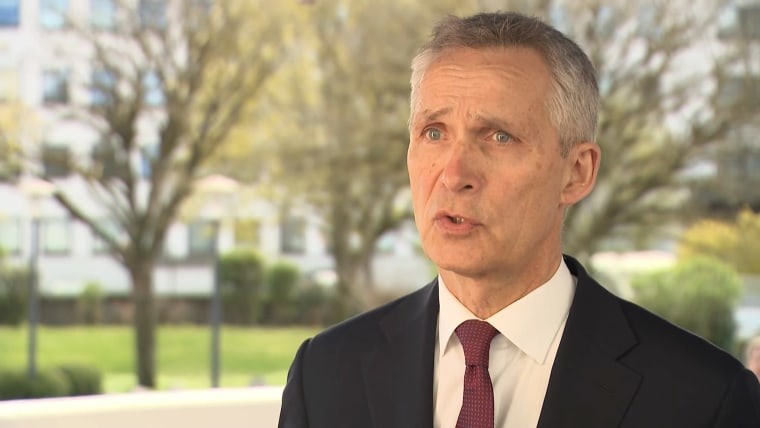
A year ago, during a meeting at Ramstein Air Base in Germany, Ukrainian government officials pleaded for their Western counterparts to provide any weapons or ammo they could after Russia’s failed siege of Kyiv caused their stocks to nearly run dry.
Now in a better position, Ukraine officials said this week they wanted to discuss their pathway to victory as they convened with allies once again at Ramstein on Friday. Ukraine’s troops are preparing for another counteroffensive that will include a plethora of Western military equipment provided by the U.S. and other countries in attendance.
The new hope from Kyiv is that, at some point, their attacks could include greater air and naval systems from the West as well.
“There is a very palpable conviction among the participants that Ukraine should win. That it will be a joint success,” Ukraine Defense Minister Oleksii Reznikov told NBC News regarding deliberations at the latest meeting at Ramstein. “Partners make it clear that they will provide support as long as needed. The trajectory for us has changed from survival to victory.”
The group — an initiative of more than 50 countries, including the U.S. and all 30 member states of NATO — are meeting for the eleventh time at Ramstein Air Base. Almost a year ago, the group met for the first time following Russia’s withdrawal from Kyiv. Ukraine was preparing for a counteroffensive around the then-occupied city of Kharkiv, the eventual success of which liberated the region.
At present, a months-long stalemate between the two sides near Bakhmut in eastern Ukraine continues to drive up casualties and burn through munition stocks. Kyiv officials arrived at the meeting on Friday with fresh aims as they prepare for their latest counteroffensive that they hope will put the Kremlin on the backfoot.
Three Ukrainian defense officials involved in the talks said in past meetings they successfully pressed for Western support and equipment, especially tanks. German Leopard 2s and British Challenger 2s are now in the country and U.S.-made M1 Abrams are expected to arrive in the coming months.
That means, the officials said, that Ukraine is pushing to create coalitions focused on boosting security in the Black Sea, as well as fighter jets. “This is the future of Ramstein,” one of the officials said. “Moving towards more sophisticated platforms.”
The Pentagon did not immediately respond to a request for comment.
The Black Sea, bounded by Russia, Ukraine, Turkey, Bulgaria, Georgia and Romania, has been a security concern since Russia’s launched its bloody invasion of Ukraine. Both sides depend on the sea for trade, and a blockade by Moscow last year almost sparked a global food crisis.
Ukraine will likely have to contend with Moscow’s naval power at some point. Russia’s Black Sea Fleet is currently headquartered in Crimea, territory occupied by Russia since 2014 and a top target of Ukraine. It is unclear what naval efforts Ukraine might pursue, as their sea capabilities are limited, but their coastal defenses have held Russia at bay.
U.K. Secretary of State for Defense Ben Wallace told NBC News last week that Ukraine’s efforts in the Black Sea could force the Kremlin’s hand.
“It’s a brave Russian captain that’s going to put a ship anywhere near the Ukrainian coast at the moment,” Wallace said. “And depending on what happens, the counteroffensive, I think those are the sort of important measures that will make Russia maybe think it’s really time to negotiate.”
As for fighter jets, the Biden administration has resisted providing them thus far. Defense Secretary Lloyd Austin emphasized the importance of ground-based air defense weapons when reporters asked at Ramstein on Friday about Ukraine’s requests for American F-16s.
Two Pentagon documents allegedly leaked by a 21-year-old member of the Massachusetts Air National Guard appear to show that Ukraine is using up large amounts of its air defense munitions as it fends off relentless Russian drone and missile attacks. Without more munitions and air support, Russia could potentially secure air superiority and begin flying warplanes over areas held by Ukrainian troops, according to one of the two documents, dated Feb. 28.
Chairman of the Joint Chiefs of Staff Gen. Mark Milley also said at the Ramstein press conference alongside Austin that the entire day had been dedicated to air defense discussions. He said decisions on providing F-16 fighter jets are “policy questions that’ll be made by political leaders.”
Yuriy Sak, an adviser to Reznikiov, said Kyiv is realistic and knows that they’re not going to get fighter jets overnight. But, he added, the planes would be necessary to win the war — and so Ukraine won’t relent on the pressure campaign.
“This war is far from over. Russia is not going to disappear. Russia is not showing any signs they want to stop this war, either,” Sak said. “For us to be more efficient and successful on the battlefield, we will need fighter jets, we will need F-16s, because they will give us superiority in the air in the long-term.”
Still, the Ukrainian officials acknowledged they have come a long way.
At the start of the war, Ukraine was a little more than six-to-eight weeks from running out of ammunition, the officials said.
The dynamic has since changed vastly from last year when few countries were willing to send munitions to Ukraine and private sellers “sold only on the terms of full prepayment,” they said.
“In the period before Ramstein [2022], we tried every way to acquire weapons and ammunition,” said one official, who noted that Ukraine had to learn how to buy vast quantities of weapons very quickly since the war. “We received some in aid, but we also bought everything we could get our hands on.”
Buying whatever they can remains a tactic, but it has become increasingly difficult to procure weapons and ammunition as demand globally has surged. Weapons manufacturers are struggling to meet the need and countries aiding Ukraine are beginning to see their own supplies run thin.
Pentagon officials said during a briefing last month that the U.S. will do whatever it takes to ramp up production and solve potential bottlenecks within the defense industry.
“Make no mistake,” Deputy Secretary of Defense Kathleen Hicks said at the briefing, “We are buying to the limits of the industrial base even as we are expanding those limits, and we’re continuing to cut through red tape and accelerate timelines.”

 Latest Breaking News Online News Portal
Latest Breaking News Online News Portal





